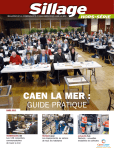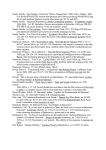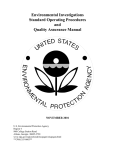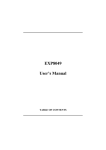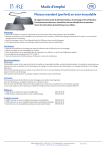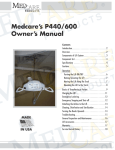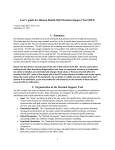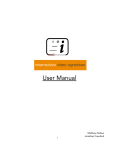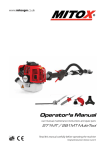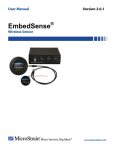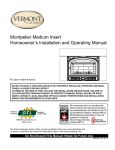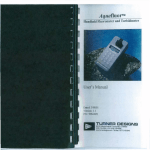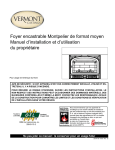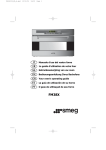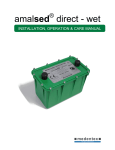Download A Guide to Proper Waste Management in Dental Offices
Transcript
The Environmentally Responsible Dental Office: A Guide to Proper Waste Management in Dental Offices Northeast Natural Resource Center of the National Wildlife Federation and The Vermont State Dental Society June 1999 People and Nature: Our Future is in the Balance The Environmentally Responsible Dental Office Guide t may come as a surprise that dental care professionals have an extraordinary opportunity to help protect and restore the nation’s rivers and lakes with simple changes in the way you dispose of waste in your office. We know, for example, that 40 states have fish consumption advisories due to mercury contamination. Mercury and other materials critical to your work can become poisons to people and wildlife if they are disposed of improperly. Your choices in disposing of those materials can make a tremendous difference. That’s why the National Wildlife Federation created this guide to running an environmentally responsible dental office. It’s intended to give dentists, dental assistants, and office staff simple ideas for changes that can go a long way in preventing the release of mercury and other potentially harmful contaminants to our nation’s streams, lakes and rivers. As you are well aware, elemental mercury is among the most common hazardous materials in the dental office. It is a toxic substance that threatens the health of humans and wildlife throughout North America. Mercury is particularly threatening because it “bioaccumulates” in the food chain, collecting and building up in the tissues of small fish and other species and then accumulating in ever-increasing amounts as those creatures are consumed by others higher up the chain. Humans, as well as wildlife, can suffer severe health effects from consuming mercurycontaminated fish. Currently, fish consumption advisories are issued in many areas to warn sensitive populations, such as pregnant women, women of childbearing age, and young children, to limit their intake of certain species of fish, or to avoid eating these fish altogether. But this approach poses problems for people who eat fish as a mainstay of their diets and for local economies that depend on the fishing industry for local jobs. A far better solution is to end the contamination at its source. And that’s where you come in. Please read this guide to learn how dental offices can limit the amount of mercury and other chemicals entering the environment by using common-sense pollution prevention and waste management techniques. You’ll also find tips on the proper handling of other harmful chemicals present in dental offices. This guide is part of the National Wildlife Federation’s ongoing efforts to provide citizens with the knowledge, the tools and the help they need to restore our nation’s rivers and lakes and keep them free from toxic pollution. That work has never been more urgent. Despite incredible progress in addressing some of the most visible sources of pollution, others, like mercury, remain a significant threat. Addressing such threats and ensuring a healthier world for humans and wildlife begins with knowledge and understanding, followed by the action of people who care. We hope you will use the information provided by this guide to act on your own desire to help. Together, we can make a difference. I Mark Van Putten, President and CEO National Wildlife Federation The Environmentally Responsible Dental Office: A Guide to Proper Waste Management in Dental Offices T he following guide was created by the National Wildlife Federation (NWF) and the Vermont State Dental Society (VSDS) in collaboration with the following project Task Force Members: Dr. Jerome DeSnyder, DDS Plattsburgh, New York Dr. Daniel Ferraris, DMD South Burlington, Vermont Doug Kievit-Kylar Pollution Prevention Planner Vermont Agency of Natural Resources Waterbury, Vermont Tom Moreau District Manager, Chittenden Solid Waste District Williston, Vermont Mark Moroukian, P.E. Environmental Engineer, Pollution Prevention Unit New York State Department of Environmental Conservation Albany, New York Hollie Shaner, RN, MSA Environmental Health Coordinator Fletcher Allen Healthcare Burlington, Vermont Founded in 1936, NWF, its members and supporters, and a national network of affiliated organizations, works to educate citizens about the need for sustainable use and proper management of our natural resources. NWF’s mission is “...to educate, inspire, and assist individuals and organizations of diverse cultures to conserve wildlife and other natural resources while protecting the Earth’s environment to promote a peaceful, equitable, and sustainable future.” The NWF’s NNRC has three overall purposes: to represent NWF on a local and regional basis among the New England states; to work with state affiliate organizations within the region; and, to conduct research, education, and advocacy programs on conservation issues of regional significance in the Northeast. The principal authors of this report are Monique Gilbert and Wendy Houston-Anderson, Water Resources Project Associates at NWF. The authors would like to thank the following people for their editorial support: Kari Dolan, NNRC Water Resources Project Manager; Eric Palola, NNRC Director; Guy Williams, NWF Pollution Prevention Specialist; Terri Goldberg, Pollution Prevention Program Manager, Northeast Waste Management Official’s Association; and, the following dental staff members: Debb Dowling; Joanna Hoke; Judy Jones; and, Dixie Vallie. The NWF would like to thank the Vermont State Dental Society for its time, donation of office space, and expertise throughout the process of developing this guide, and the project’s Task Force, which greatly contributed to the overall success of this undertaking. Funding for this guide was provided through a grant from the Lake Champlain Basin Program to the National Wildlife Federation’s Northeast Natural Resource Center. NWF would also like to thank the Ward M. and Mariam C. Canaday Educational and Charitable Trust for their financial support. The views expressed in this report are the views of the National Wildlife Federation and not those of the Task Force. For additional copies of this guide or more information, please contact: The National Wildlife Federation Northeast Natural Resource Center 58 State Street Montpelier, Vermont 05602 (802) 229-0650 [email protected] Peter Taylor Executive Director, Vermont State Dental Society South Burlington, Vermont The National Wildlife Federation’s Northeast Natural Resource Center (NNRC), based in Montpelier, Vermont, is one of ten field offices of NWF. NWF is a non-profit conservation and education organization with headquarters in Vienna, Virginia. or Vermont State Dental Society 100 Dorset Street, Suite 18 South Burlington, Vermont 05403 (800) 640-5099 [email protected] Table of Contents Introduction.................................................................................................................... Page 4 Why is Mercury a Concern?..................................................................................................... 4 Reducing Mercury Contamination – Opportunities for Dentists........................................... 5 • Pollution Prevention........................................................................................................5 • Best Management Practices.............................................................................................5 Dental Office Wastes - Handling Procedures............................................... Page 6 Amalgam (Containing Mercury and Silver)..............................................................................6 • Steps You Can Take - Some General Guidelines.......................................................... 6 • Elemental Mercury........................................................................................................6 • Amalgam Capsules........................................................................................................7 • Scrap Amalgam.............................................................................................................7 • Chairside Traps............................................................................................................. 7 • Vacuum Pump Filters................................................................................................... 8 • Additional Sources of Mercury in Dental Offices....................................................... 8 • Amalgam Separators.....................................................................................................9 • Plumbing Replacement and Repairs........................................................................... 9 • Office Renovations....................................................................................................... 9 Used X-Ray Fixer Solution (Containing Silver)................................................................... 10 X-Ray Developer ................................................................................................................. 10 Cleaners for X-Ray Developer Systems .............................................................................. 11 Lead Foils, Shields and Aprons ...........................................................................................11 Chemiclave/Chemical Sterilant Solutions.............................................................................11 Disinfectants, Cleaners and Other Chemicals..................................................................... 12 Office Waste......................................................................................................................... 12 • General Office Waste................................................................................................. 12 • Fluorescent Bulbs....................................................................................................... 12 • Batteries...................................................................................................................... 12 Resource Handbook ......................................................................... Located in Back Pocket Dental Amalgam Recyclers........................................................................................................1 Dental Amalgam Separator Product Vendors.......................................................................... 5 Hazardous Waste Programs..................................................................................................... 5 Hazardous Waste Haulers........................................................................................................ 6 Lead Foil Recyclers................................................................................................................... 6 Mercury Recyclers..................................................................................................................... 7 Occupational Safety and Health Administration (OSHA)....................................................... 7 Compliance Supplies and Equipment Vendors ............................................................... 7 Regional Solid Waste Contacts................................................................................................. 7 Lake Champlain Basin – New York.................................................................................. 7 Lake Champlain Basin – Vermont ................................................................................... 7 Rental Test Equipment Companies.......................................................................................... 8 Silver Reclamation Facilities......................................................................................................8 State Dental Societies............................................................................................................... 8 State Departments of Environmental Conservation Contacts................................................. 9 Dental Office Waste Management Tables.............................. Located in Back Pocket Introduction Why is Mercury a Concern? One possible environmental impact from the practice of dentistry results from the unwanted release of elemental mercury and mercury-containing amalgam from dental offices. Mercury is a persistent, toxic contaminant and it bioaccumulates in the tissue of fish. High concentrations of mercury in fish pose serious health risks to people and wildlife that consume them. New York and Vermont began testing for mercury in fish as early as 1969 and 1970, respectively. Studies in both states illustrate that mercury levels vary by species and among waterbodies, but appear to be highest in larger (older), piscivore (fish-eating) species. Both states currently have state-wide fish consumption advisories in effect.1 Populations that are particularly sensitive to the health risk of consuming contaminated fish include: pregnant women, women of childbearing age, children, and people dependent upon fish for their daily diet. There are several ways that mercury from dental amalgam can get into the environment: T he Environmentally Responsible Dental Office: A Guide to Proper Waste Management in Dental Offices is intended to assist New York and Vermont dentists in dealing with mercury and other dental office waste problems in a proactive way. This guide provides dentists with the information they need to properly dispose of mercury and amalgam waste, and provides suggestions for managing the other wastes that result from the day-to-day activities of a dental office such as: used X-ray fixers and developers; cleaners for X-ray developer systems; lead foils, shields and aprons; chemiclave/chemical sterilant solutions; disinfectants, cleaners, and other chemicals; and, general office waste. Throughout the document, reference will be made to the appropriate parties to contact for information on issues such as amalgam recycling, silver reclamation, and hazardous waste disposal. At the back of this Guide, in the inside cover pocket, there is a separate Resource Handbook that contains lists of companies, contact names, and/or phone numbers to assist dentists and dental office staff in obtaining the information they need to take action on the guidance provided in this document. The following symbol will be used throughout the Guide to indicate when the Resource Handbook should be consulted for additional information: = refer to the Resource Handbook in the inside • Wastewater: Amalgam that is rinsed down drains or escapes from poorly maintained chairside traps and vacuum pump filters enters the wastewater stream and eventually the wastewater treatment plant or the septic system. Any mercury contained in treated wastewater will either end up in the sewage sludge, which may be land applied (under an appropriate permit), or in the liquid effluent to be discharged into lakes or rivers. • Medical Waste: Scrap amalgam, both contact and non-contact, should not be treated as medical waste. Amalgam that is improperly put into red biohazard bags might be either incinerated or autoclaved. If amalgam is present in waste that is incinerated, the mercury will volatilize and enter the atmosphere. The volatilized mercury then precipitates to the ground or a waterbody. If amalgam is present in waste that is autoclaved, the volatilized mercury will escape from the autoclave when the door is opened, presenting an immediate health hazard to dental office staff. • Garbage: If amalgam scrap is discarded into ordinary trash, it may eventually be incinerated (see previous paragraph) or placed in a landfill. If discarded amalgam scrap ends up in a landfill, it may lead to soil and/or water contamination. cover pocket. Also located at the back of the Guide, in the inside cover pocket, are two Dental Office Waste Management Tables–laminated tables of consolidated dental office waste management options and restrictions, organized according to the type of waste. These tables are designed to be displayed on the wall in the dental office for quick and easy reference. 4. Most landfills are outfitted with leachate collection systems. Leachate results from the normal decomposition of the garbage in landfills. The collected leachate is piped to the local publicly owned treatment works (POTW), where it can be released to the environment through ways described under “wastewater” above. • Pollution prevention programs can also include: education and training, good housekeeping practices, chemical inventory control, and recycling. Elements of a successful pollution prevention program are: (a) a written statement of policies and goals tailored to each dental practice; (b) a commitment to consistent administration of the program; and, (c) continuous monitoring of pollution prevention policies and goals by the dentists and their staff members. You should consider implementing a pollution prevention program for your dental office using the following pollution prevention practices: Antiquated Techniques: Older techniques that use bottles to dispense elemental (also referred to as free, bulk, or raw) mercury for amalgam production can lead to accidental spills and increase the chances that elemental mercury will end up in the wastestream. In addition, if the elemental mercury is poured into the drain, it may settle in sink traps, gradually releasing into the wastewater over time. Use amalgam substitutes in cases where they are Reducing Mercury Contamination – Opportunities for Dentists Dentists have many options available to them to reduce the amount of amalgam inadvertently leaving their office. The information presented in this guide falls into two categories of waste management strategies: pollution prevention actions and control actions–also called “best management practices.” appropriate, ethical, and economically feasible. Use non-hazardous or biodegradeable detergents for clean-up. Use non-chromium containing X-ray developer system cleaners. Educate your staff and cleaning service on these practices so they can properly follow the program that you have established. Best Management Practices While pollution prevention is the ideal solution for solving the mercury problem, it is not always feasible in practice. Therefore, the following sections present information on best management practices for the dental office. Best management practices are economically achievable measures or actions that can be used to control or reduce the entry of pollutants (mercury, amalgam and other dental office wastes) into the environment. Pollution Prevention The goal of pollution prevention is to reduce or eliminate the use of toxic or polluting substances at the source. Pollution prevention activities and recycling in dental offices are essential in order to minimize releases of polluting substances into the sewer system, medical waste, or ordinary trash. An effective pollution prevention strategy is to use products that are less harmful to the environment. For dentistry, this strategy includes the development and use of amalgam substitutes, as appropriate, and the use of less hazardous cleaning products. 1Northeast States for Coordinated Air Use Management (NESCAUM), et.al. 1998. Northeast States and Eastern Canadian Provinces Mercury Study, A Framework for Action. pp. IV-6 - IV-7. 5. Minimize the generation of amalgam waste. Dental Office Wastes – Handling Procedures Don’t mix a two-spill capsule if a one-spill capsule will do. Less waste means less amalgam that needs to be recycled. Recycle as much amalgam as possible. When removing an existing amalgam, attempt to remove it in “chunks” so that it is more likely to be caught in the chairside trap. REMINDER: = refer to the Resource Handbook in the inside cover pocket. Amalgam Never put scrap amalgam in the sharps container. (Containing Mercury and Silver) Never put scrap amalgam where it will end up in the red biohazard bag. Never discard scrap amalgam in the trash. Steps You Can Take– Some General Guidelines: Never rinse scrap amalgam down the drain. Use amalgam substitutes in cases where they are Never remove excess amalgam from the amalgam well with the high-speed suction (the vacuum line). appropriate, ethical, and economically feasible. Convert to single use amalgam capsules. This Never clean up a mercury spill using a vacuum cleaner. change will help to minimize the chance of an accidental mercury spill. In the event of a mercury spill, put on nitrile Never place extracted teeth with amalgam restorations in the red biohazard bag. They should be placed in the CONTACT AMALGAM container. Use universal precautions when handling extracted teeth (glasses, gloves and mask). gloves and clean it up immediately. (Do not use latex gloves as mercury can penetrate latex.) Mercury spill kits are available from a number of sources, including: companies that specialize in Occupational Safety and Health Administration (OSHA) compliance supplies and equipment (); amalgam recyclers (); and, dental product suppliers. Before purchasing a kit, make sure it comes with complete instructions on how to perform a spill clean-up. Train several staff members in proper spill clean-up procedures. Elemental Mercury uncontained presence of mercury in your dental office, due to historical or recent mercury spills, equipment is available for the detection of mercury vapor in the workplace environment, and for the location of mercury spills. This equipment can be rented from rental test equipment companies (). Never rinse elemental mercury down the drain. Never dispose of elemental mercury in the trash. (also referred to as free, bulk, or raw mercury) Use precapsulated alloy to eliminate the possibility of an elemental mercury spill. In the event that elemental mercury is present in your dental office, it should be properly handled in the following way: If you are concerned about the possible Never dispose of elemental mercury in the sharps container, or as medical waste. 6. Recycle unused elemental mercury. Many hazardous waste haulers () and dental amalgam recyclers () will accept elemental mercury for recycling. If you have any other questions regarding the recycling of elemental mercury, you can contact the following state offices: in New York, contact the New York Department of Conservation, Bureau of Hazardous Waste Management, Technical Determination Section (); in Vermont, contact the Vermont Department of Environmental Conservation, Waste Management Division, Resource Conservation and Recovery Act (RCRA) Section (). If contact amalgam must be disinfected before shipment to your recycler, do not use any method that utilizes heat. The heat will cause the mercury to volatilize and be released to the environment. If you store scrap amalgam under used radiographic fixer, water, or other liquid, do not, under any circumstances, decant the liquid down the drain. Contact your dental amalgam recycler () or hazardous waste hauler () for more information on how to dispose of this material properly. If a small amount of elemental mercury is to be disposed of, initiate a reaction with amalgam alloy to form scrap amalgam, which can then be recycled through your amalgam recycler (). Chairside Traps The control of waste dental amalgam includes proper management of the traps and filters used in your office vacuum system. Disposable amalgam traps are preferable to reusable traps because of the difficulty in effectively removing amalgam particles from the trap without spilling them into the drain or garbage. In addition, consider replacing 40 mesh traps with 100 mesh traps if your suction system can function adequately with the smaller mesh. Finer screens may be more effective at trapping amalgam particles. However, they may require cleaning and changing more often. Most solid waste districts (in Vermont only) offer elemental mercury recycling programs, which allow dentists to safely dispose of their elemental mercury. Call your regional solid waste district () to inquire about such programs. Amalgam Capsules After mixing amalgam, the empty amalgam capsules containing no visible amalgam may be disposed of in the garbage. Any defective capsules that cannot be emptied should be placed with the non-contact scrap amalgam so they can be recycled. Be sure to check with your amalgam recycler () to see if they will take capsules with your scrap amalgam. Scrap Amalgam Be sure to check with your dental amalgam recycler () to determine if they will accept disposable amalgam traps in the same container with your contact amalgam. Salvage and store all contact and non-contact scrap amalgam in separate, appropriately labeled, tightly closed containers. Recycle scrap amalgam through an amalgam recycler (). The following recommendations will help you to properly manage your trap systems: Follow the requirements of your amalgam recycler for the storage, disinfection and shipping of scrap amalgam. Disposable and Reusable Amalgam Traps: Use universal precautions when handling the chairside trap. Change chairside amalgam traps as often as necessary. 7. Vacuum Pump Filters Flush the vacuum system with disinfecting line solution before changing the chairside trap. ✔ ✔ (by the central suction pump) Replace vacuum pump filters regularly as recommended by the equipment manufacturer. The best method is to flush the line at the end of the day, and then change the trap the next morning before the suction is used. This method will allow the particles in the trap to dry. Use universal precautions when handling the filters. Remove the filter. While holding it over a tray or other container that can catch spills, decant as much liquid as possible without losing visible amalgam. The decanted, amalgam-free, liquid can be rinsed down the drain. An alternative method is to flush the system with a cleaning solution according to the product’s directions; then remove the lid from the trap and allow air to pass through the trap until the contents are dry (usually not more than five minutes). Put the lid on the filter and place it in the box in which it was originally shipped. When the box is full, the filters should be recycled. Be sure to check with your amalgam recycler () to ensure that they will take these filters. Follow the steps below that apply to the type of trap you have. Disposable Amalgam Traps: Do not dispose of used vacuum pump filters as medical waste. Open the chairside dental unit to expose the amalgam trap. Additional Sources of Mercury in Dental Offices Remove the amalgam trap and place it directly into the contact amalgam recycling container. You may need to have a contact amalgam container that is large enough to accommodate the disposable chairside traps. Any electrical equipment with switches, relays or temperature controls (thermostats) may contain mercury and should be disposed of through a hazardous waste hauler (). • If the trap is visually clean, it can be put in the trash or re-used. Visually clean traps have been determined to be nonhazardous. A heavily contaminated trap should always be recycled. Store contaminated traps in the contact amalgam container. Mercury thermometers and blood pressure units are sources of elemental mercury. The following steps should be followed in the event that one of these items should become broken. • Reusable Amalgam Traps: Remove non-amalgam fragments such as cement from the trap with cotton forceps and discard in the garbage. Remove all visible amalgam by tapping the contents into the container labeled “CONTACT AMALGAM.” Close the cover tightly. Do not clean reusable traps under running water or discharge the trapped amalgam into the wastewater system. Do not discharge the trapped amalgam into the sharps container, biohazard bag, or trash. 8. Put on nitrile gloves. (Do not use latex gloves.) Clean up all visible elemental mercury using a mercury spill kit. Mercury spill kits are available from a number of sources, including: companies that specialize in Occupational Safety and Health Administration (OSHA) compliance supplies and equipment (); amalgam recyclers (); and, dental product suppliers. Before purchasing a kit, make sure it comes with complete instructions on how to perform a spill clean-up. Train several staff members in proper spill clean-up procedures. Place all contaminated items (materials used during the clean up procedure and broken pieces of glass) in a sealable plastic bag or container. Label the bag or container as “Mercury Waste”. Dispose of all contaminated materials through a hazardous waste hauler (). • The unit should operate quietly. • The unit should come with a “fail-safe” mechanism that protects you from a spill or back-up in the event that a blockage occurs. • The unit should install centrally so that the whole wastewater stream passes through it before discharging into the sewer system. • The unit should be reasonably priced. Obtain information from the companies on the total cost for all services, including cost of the unit over a 5-10 year period, before making a decision. Never dispose of contaminated waste in the sharps container, biohazard bag, or trash. Never dispose of elemental mercury down the drain or in the sharps container, biohazard bag, or trash. Amalgam Separators Your office may wish to consider purchasing an amalgam separator. The ability of amalgam separators to remove amalgam from the dental wastewater may be superior to filters and traps used in chairside dental units and vacuum lines. These separator systems are used to capture scrap amalgam in wastewater which is too fine to be removed by a trap or a screen. Amalgam separators are used in Europe and are currently being evaluated in selected areas of the United States. Contact your state dental association () or an amalgam separator vendor () for more information. If you decide that you want to purchase an amalgam separator, be prepared to shop around for the machine that works best for you. These separators vary widely in sophistication and effectiveness. The following criteria should help you select the right system.2 • 2Balogh, Cynthia Welland and Paul G. Rubin. 1998. Removal of Mercury from Dental Amalgam Wastewater. A New Prescription: Pollution Prevention Strategies for the Health Care Industry Conference. pp 131-155. Plumbing Replacement and Repairs After your office adopts its new amalgam management practices, it may be a good time to clean or replace sink traps. Mercury from past practices often settles at low points such as sink traps and sumps. The slow dissolution of the mercury in a sink trap or sump can release mercury into the wastewater for years after past disposal practices have been corrected. The system should be effective, meaning that the company should be able to prove that it can remove the amalgam from the wastewater, regardless of particle size. • There should be no compromise in suction Whenever plumbing parts are removed or cleaned, caution should be taken to avoid spilling the contents in case amalgam or mercury are present. power. • • • You may want to consider a unit that is “hands-off,” meaning that the dentist or staff does not have to perform a series of manual operations, or be required to handle and change filters. Pour and brush out the sludge and handle it as you would handle contact amalgam. The plumbing parts can then be put back in place or recycled. The captured amalgam should be recycled. Make sure that the company which sold you the unit also arranges for the recycling of the captured amalgam. The company needs to provide you with the appropriate information on how to recycle the captured amalgam. Office Renovations Alert renovators to the possibility of historical mercury spills that may have resulted in the presence of mercury in carpets, floor cracks, behind moldings and other areas where elemental mercury may have been used, or where amalgam capsules may have been spilled. Simplicity of design is a plus. There will be fewer chances for something to go wrong. 9. Purchase your own silver recovery unit. If you suspect the presence of uncontained Please check with your local publicly owned treatment works (POTW) prior to purchasing a silver recovery unit to ensure that the level of silver removal meets the POTW’s discharge standards. If it does, you may rinse the recovery process waste down the drain. (Check in the phone book under your town’s Public Works Department for the number of your local POTW). mercury in your dental office due to historical or recent mercury spills, equipment is available to detect mercury vapor and locate mercury spills. This equipment can be rented from rental test equipment companies (). Guidance is available on the proper disposal of renovation debris. In New York, contact the New York State Department of Environmental Conservation, Bureau of Hazardous Waste Management, Technical Determination Section (). In Vermont, contact the Vermont Department of Environmental Conservation, Waste Management Division, Solid Waste Program (). If your dental office is on a septic system, do not wash the liquid that has gone through the silver recovery process down the drain. The recovery process waste may disrupt the proper functioning of the septic system. Therefore, recovery systems may not be a viable option for offices on septic systems. Used X-Ray Fixer Solution X-Ray Developer (Containing Silver) Do not mix X-ray developer and used X-ray fixer. The silver-laden used X-ray fixer is considered hazardous waste and can not be flushed down the drain. Please refer to the previous section on Used X-Ray Fixer Solution for proper handling procedures. U sed fixer is the solution left over from Xray processing. The used fixer is considered a hazardous waste because of its high silver content. Used fixer should be reclaimed off-site by another company, handled by a hazardous waste management firm, or reclaimed in-house. Reclaiming the silver in used fixer conserves a valuable resource and reduces your business liability. Many reclaimers will pay to take your silver. Suitable recycling methods for used fixer include: Check with your local publicly owned treatment works (POTW) to determine if waste X-ray developer can be flushed down the drain. (Check in the phone book under your town’s Public Works Department for the number of your local POTW). If X-ray developer is acidentally mixed with used X-ray fixer, the mixture must be disposed of through a hazardous waste hauler (). Reclamation Facility/Hazardous Waste Management Firm. Used fixer can be taken to a silver reclamation facility () that is licensed to accept hazardous waste, or disposed of through a hazardous waste hauler (). In either case, make sure you get a receipt or certificate of reclamation. 10. Cleaners for X-Ray Developer Systems M Dispose of lead foils, shields and aprons through a hazardous waste hauler (). Check with the manufacturer for recycling possibilities for lead aprons that become worn out or damaged. Remember to always get documentation from the company handling your lead waste confirming that the waste has been disposed of properly. any cleaners for X-ray developer systems contain chromium. Chromium is considered a toxic substance that must be managed as a hazardous waste. Chemiclave/Chemical Sterilant Solutions Dispose of chromium-containing cleaners through a hazardous waste hauler (). Check the package label or the Material Safety Data Sheet (MSDS) to see if the cleaner you use contains chromium. If it does, ask your supplier to provide a non-chromium cleaner. S Never put a cleaning solution, disinfectant or any other process waste into a septic system, regardless of its concentration. It may disrupt the proper functioning of the septic system. pent chemiclave solution is the liquid left over from the chemical sterilization of dental instruments. This used solution is an ignitable waste because it contains more than 24% alcohol and has a flashpoint below 140ºF. Dilute the spent chemiclave solution with at least 4 parts of water (4 parts water to one part chemiclave solution) or more before discharging down the drain. Lead Foils, Shields & Aprons Do not wash the chemiclave solution down the drain undiluted, or put in the garbage. Never put a cleaning solution, disinfectant or any other process waste into a septic system, regardless of its concentration. It may disrupt the proper functioning of the septic system. Do not put the lead foil that shields X-ray film, protective lead shields, and lead aprons into the trash or into biohazard bags. The lead content of these items makes them hazardous waste, even if they are recycled for their scrap metal content. 11. Disinfectants, Cleaners and other Chemicals Fluorescent Bulbs: Recycle fluorescent bulbs through your regional solid waste district (). Fluorescent bulbs are hazardous waste and a significant source of mercury. They should not be placed in the trash. Do not place fluorescent bulbs in the trash. Follow the label directions on the product container for guidance on the proper handling and disposal of used disinfectants and cleaners, along with the residue remaining in the product containers. Batteries: Recycle all types of batteries. Most, if not all, batteries have hazardous properties and should be recycled. Contact your regional solid waste district for recycling directions (). • Single Use Batteries: As a result of federal and state legislation, mercury is no longer added to domestically produced alkaline batteries. However, certain other kinds of batteries– including certain button batteries, some medical batteries, small sealed lead-acid batteries, and other specialty batteries– continue to contain mercury and other metals that are intentionally added. • Rechargeable Batteries: Batteries such as nickel/ cadmium (Ni/Cd) that are no longer useful are hazardous waste and should also be recycled since they contain lead and cadmium. Recycle the empty container through your local program or dispose of it in the trash. Alcohols, ethers, and peroxides are considered ignitable and must not be discarded down the drain because they could explode. These materials are considered to be hazardous waste. Unused products should be disposed of through a hazardous waste hauler (). Never put a cleaning solution, disinfectant or any other process waste into a septic system, regardless of its concentration. It may disrupt the proper functioning of the septic system. Office Waste General Office Waste: Do not place batteries in the trash, biohazard bag, or sharps container. Contact your trash hauler or your regional solid waste district () for information on how to start an office waste recycling program. Recycle aluminum, glass, plastics, newspaper, corrugated cardboard, paperboard, and office paper through your trash hauler or local recycling program. Due to confidential patient information you may want to have office paper shredded prior to recycling. Recycle spent toner cartridges that have been used in printers and copiers. Printed on recycled paper with soy-based inks Design: Mirabile Graphics Illustrations: Carolyn Shapiro 12. For additional copies of the Resource Handbook or Dental Office Waste Management Table, please contact: The National Wildlife Federation Northeast Natural Resource Center 58 State Street Montpelier, Vermont 05602 (802) 229-0650 [email protected] or Vermont State Dental Society 100 Dorset Street, Suite 18 South Burlington, Vermont 05403 (800) 640-5099 [email protected] People and Nature: Our Future is in the Balance















